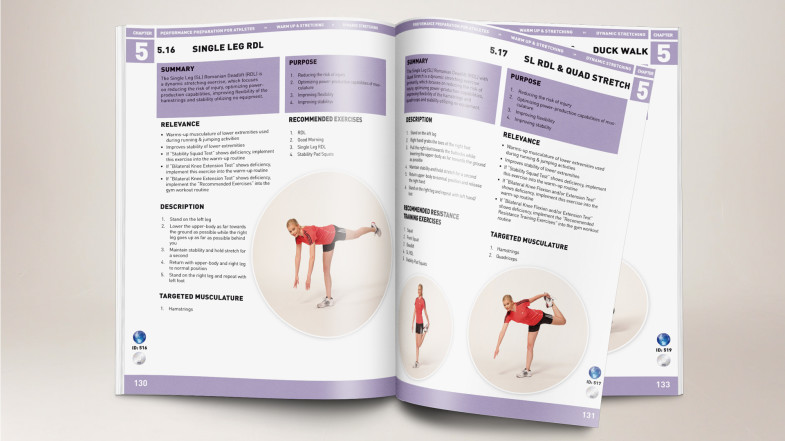The first edition of Advanced Concepts of Strength & Conditioning for Tennis provides a developmental approach to the various aspects of strength and conditioning for tennis.
Over 1000 athletes have been developed using the information and procedures provided in this tennis conditioning book. They are supported by a selected pool of peer-reviewed references.
Any quality textbook shouldn’t merely provide an explanation of the underlying scientific principles but also illustrate how the information can be effectively applied in order to yield a superior outcome.
From a coach’s or educational standpoint, there was the lack of a cohesive, quality, tennis-specific resource that provided coaches and players with a solid educational foundation for the effective development of various athletic performance parameters.
Therefore, the first edition of Advanced Concepts of Strength and Conditioning for Tennis provide you with a comprehensive and cohesive body of knowledge.
It also supplies applications that can be utilized to develop all aspects of tennis conditioning for all skill levels.
You will gain insight into how to evaluate and enhance all aspects of tennis conditioning in a developmental fashion. That is essential for improving the overall level of play on the tennis court while minimizing the risk for injury.
If you are interested in more information you can read on how I ended up writing a tennis conditioning book.
Background
In this context, strength & conditioning can be defined as the study of athletic performance optimization through various forms of training.
Advanced Concepts of Strength and Conditioning for Tennis relates to all forms of training suited for tennis players.
It is intended to provide a strength & conditioning foundation, which strives to optimize force production capabilities of the human body during unstable, dynamic applications, as experienced during a tennis match.

Although the subject of strength & conditioning has been presented from many different angles, I have focused on refining the interaction between the musculoskeletal – and nervous system for optimal sports performance.
I hope this tennis conditioning book provides a valuable educational resource to a wide range of tennis players and coaches, both recreational and professional.
Strength and Conditioning for Tennis Approach
It has been my goal to write a textbook that illustrates a developmental approach to tennis conditioning that can easily be understood and utilized by tennis players and coaches of all skill levels.
The content is organized in sensible, constructive order where each chapter first provides explanation of underlying scientific principles.
Then we present you practical solutions in form of applications or exercises.
They have been selected and grouped based on purpose, training emphasis, and skill level.

This tennis conditioning book represents the essence of nearly 10 years of experience as a professional coach working with collegiate and professional athletes.
This experience comes from a combination of research, study, playing, coaching, and teaching activities that have laid the foundation for a better understanding of the different areas of expertise required from a coach.
During my time at Florida International University and being on tour, I developed an integrated strength & conditioning approach consisting of eight distinct training phases.
This integrated approach is based on a library of research material, applications, and exercises aimed at developing and maximizing the athletes’ athletic potential while minimizing the risk for injury. Thereby helping them to raise their game to the next level.
Over time, this library of research material, applications, and exercises evolved into the blueprint for this 1st edition of Advanced Concepts of Strength and Conditioning for Tennis.
Strength and Conditioning for Tennis Organization
The organization of the tennis conditioning book reflect the sensible steps used during the developmental approach to athletic conditioning.
The textbook contains eight chapters, divided into three sections.
Section I
Section I, consisting of chapters 1 – 3, provides the essential topics of career development, kinesiology, and exercise physiology.
Including an introduction to the four pillars of success, terminology, basic concepts, and basic structure and function of the musculoskeletal system and the body’s internal environment.
Section II
Section II, chapters 4 through 7, focus on the various aspects of athletic conditioning in sensible order.
Chapter 4, Fitness Assessment, lays the initial foundation for optimal training by addressing methods of performance measurement.
Fitness assessments must take place before a comprehensive training program can be developed and implemented.
Chapter 5 provides various static, dynamic, and ballistic stretching techniques. They can be used to correct possible deficiencies found during the fitness assessment.

Chapter 6 introduces a formidable arsenal of resistance training exercises that can be utilized during all phases of training.
Whereas chapter 7 provides exercises for speed, agility, and quickness (SAQ) development through a wide range of medicine ball, speed ladder, cone, and various other body weight drills.
Section III
Section III encompasses the final chapter addressing current research, hot topics, and applications concerning proper sports nutrition such as nutrient timing and ingestion.
The tennis conditioning book is specifically designed for the purpose of teaching and applying.
Therefore, exercise science concepts are being introduced at the beginning of the chapter followed by corresponding practical applications or exercises.
That allows the reader to expand his/her competency while offering a resource of immediate practical solutions and training recommendations.
Practical applications presented include:
- body composition tests
- flexibility and performance tests
- dynamic stretching, static stretching, and ballistic stretching
- auxiliary exercises, compound exercises, integrated strength & power exercises, stability exercises, functional exercises, ballistic exercises, and plyometric exercises
Multiple practical applications a presented throughout each chapter providing detailed descriptions in conjunction with pictures, diagrams, and videos.
This information provides the foundation for understanding many of the tests and exercises used in strength & conditioning for amateur and professional tennis players.


